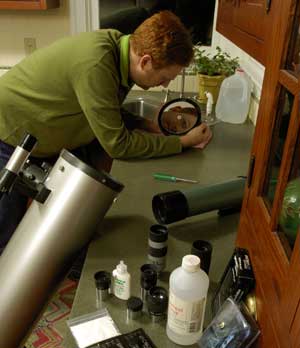
When cleaning lenses and mirrors, the most important rule is the doctor's Hippocratic Oath: "First, do no harm."
Craig Michael Utter
Any telescope or binocular that you use for astronomy, no matter how humble it may be, deserves the best care you can give it including the cleaning of telescope optics. Much of the time you’ll be using it right at the limit of its capabilities, and when you’re trying to see very faint objects or fine detail, little things make a big difference.
Then again, life is full of imperfections, and there’s no point fretting about them. Every telescope gets dirty. Dirt on lenses or mirrors scatters light, making dark skies less dark and bright objects less crisp — but not nearly as much as you probably think. The right attitude toward telescope optics means knowing when to be vigilant and when to relax.
The first tactic against dirt is defensive, and this is when you should be vigilant. Keep the lens caps on when the instrument is not in use. If it’s missing a cap, make your own; a shower cap, or a plastic bag or dishcloth held over the front of the tube by a rubber band, works fine. As for the eyepiece holder, a plastic canister for 35-mm film fits the standard 1¼-inch focuser size. So does a wad of cloth.
I store my two reflectors with their main and secondary mirrors both facing somewhat down. That way dust won’t settle on them in storage. Eyepieces should be capped on both ends or kept in plastic bags or small plastic food containers. Telescope retailers sell cheap, durable cases to store and protect eyepieces.
Never touch the surface of a lens or mirror. The acids in skin oil can attack optical coatings over time. If you do leave a fingerprint on, say, a binocular lens, clean it off using the method described below.
So much for vigilance — now to relax. Dirt happens, and in moderate amounts it has amazingly little effect on performance. In his book Star Testing Astronomical Telescopes, Harold Richard Suiter analyzes the effects of dirty, telescope optics in full mathematical detail. His conclusion? “The maximum amount of dirt [that a perfectionist] should tolerate on the telescope optics is about 1/1000 of the surface area, the size of a single obstruction about 1/30 of the diameter.” In other words, on a 10-inch-diameter telescope mirror you can have as much dirt as in a completely opaque blot a third of an inch across. That’s quite a lot of crud to have no effect at all.
“Don’t decide to clean mirrors on the basis of shining a light down the tube at night,” advises Suiter. “All mirrors fail such a harsh inspection.” After you’ve done what you can to prevent dust, ignore it.
There’s a good reason to ignore dirt, aside from reducing the things to worry about in life. A dirty lens or mirror can always be made clean, but a scratched one is scratched forever. Cleaning causes tiny scratches, or sleeks, if you don’t do it right, and maybe even if you do. A few sleeks don’t matter, but a lot of them will. So clean your telescope optics rarely.
But if things on your telescope optics get really bad and you decide a cleaning has to be done, here’s how.
Telescope Optics Care: Cleaning Lenses
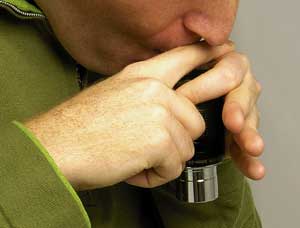
To remove dust from an eyepiece lens, suck air as hard as you can between a finger and the lens. Don't blow or you'll leave droplets of spit.
Craig Michael Utter
The quick and easy way to dust eyepieces is to lay a finger across the eye end (without touching the glass!) and suck air under your finger past the lens. (This moves the dust from the eyepiece to your lungs, but every astronomer knows which is more important.) The job takes about one second.
If that doesn’t do it, the traditional method for dusting optics is to brush lightly with a camel’s-hair brush. Sold in camera shops, these brushes have soft bristles with minimum tendency to scrape grit against a lens. Brush very lightly. Store the brush in its container or a plastic bag.
Camera shops also sell cans of compressed gas for blowing dust off lenses. Be careful with the kind that use liquid propellants; these have a reputation for spitting onto the glass and leaving a residue if the can is tipped or shaken in use. Blowing (instead of sucking) with your own breath is also likely to leave spit marks.
For tougher dirt or stains, various lens-cleaning solutions are available. Good ones are pure isopropyl alcohol or methyl alcohol (methanol), available in drug stores and hardware stores, respectively. Standard, diluted isopropyl rubbing alcohol works well too and is easier to find, but avoid alcohol preparations with other ingredients that may leave stains. Camera shops sell lens-cleaning fluids such as Crystal Clear, which is pure methanol, but you can get methanol much cheaper in a hardware store. Also available are “lens pens” with a soft, retractable, solvent-impregnated cleaning pad.
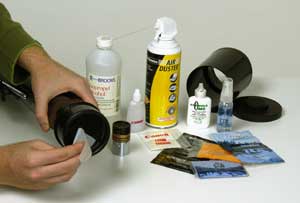
When cleaning lenses, apply fluid to your cleaning pad, not the lens itself. You don”™t want any fluid to seep in around the lens's edges; it may carry dissolved gunk to glass surfaces inside and leave stains where you can't reach them.
Craig Michael Utter
You’ll need a soft, grit-free wipe. A well-washed piece of pure cotton cloth works well. Moisten it with the fluid and swirl the fluid gently across the lens, applying no pressure. If necessary, rub dry with a fresh piece very gently. Don’t drop liquid directly onto the glass. It’s liable to seep around the edge of the lens into the cell and carry dissolved grime onto interior surfaces, staining them.
Eyelash and fingerprint oil may discolor coatings permanently if left on long enough. But such stainsare only cosmetic, eyepiece manufacturers insist, and should have no detectable effect on performance.
If problems develop inside the eyepiece, it’s best not to take it apart. You are almost certain to tilt and jam (“cock”) a lens element, and if you try too hard to uncock it, the edge will chip. Instead, call the manufacturer and ask about a professional cleaning.
The big front lenses of refractors and mirror-lens telescopes should not be taken out of their cells except by an expert. Again, the danger is cocking and chipping the glass — or not re-assembling everything exactly the way it was! Big lenses can be cleaned right in place the same way as small ones, by using more time and fluid. Resist any urge to hurry the job.
Telescope Optics Care: Cleaning a Mirror
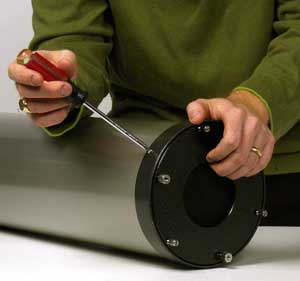
Undo the screws on the sides to remove the main mirror from the back of a reflector.
Craig Michael Utter
To clean the mirrors in a reflector telescope, you’ll need to be confident about taking the telescope apart and putting it back together again — and about collimating the telescope (aligning the mirrors) once it’s back together.
How do you know whether your mirrors need cleaning? It’s simple: if you’re asking the question, they don’t! Leave the mirrors alone unless they are so obviously crudded up (probably due to careless storage) that there’s no question.
If you do go ahead and clean your telescope optics, here’s the cleaning procedure.
Undo the screws attaching the main mirror’s cell to the back end of the tube. Reach in the back and gently pull out the cell with the mirror inside it. Unscrew the clips holding the mirror in, and push the mirror out from the back without touching its shiny surface.
You’ll also need to remove the holder for the small secondary mirror inside the front end of the tube, and then get the secondary mirror out of the holder.
The first and most important cleaning step is to remove all grit correctly.Ordinary house dust contains bits of rock powder, and rubbing this stuff against glass (or, actually, against delicate optical coatings) causes sleeks. So you’ll need to get rid of grit without rubbing.
You’ll need the kitchen sink, two towels, liquid detergent, a bottle of distilled or demineralized (“de-ionized”) water (available in drugstores), and a package of sterile cotton (if it’s sterile it’s more likely to be grit free). Wash out the sink, rinse it well, and lay a folded towel on the bottom. Take off any jewelry from your hands and wrists. Put the mirror face-up onthe towel, and with the drain open, blast the mirror’s surface with room-temperature water for a few minutes. This will remove most dust and grit safely.
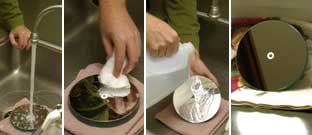
From left to right: The safest way to remove grit from a telescope mirror is to blast the surface with tap water. That may be all you need to do. If dirt remains, swish the surface lightly with clean cotton in lukewarm water and detergent. Rinse with tap water, then do a final rinse with distilled water (to prevent water stains). Set on edge to dry. You can draw off remaining drops with the corner of a paper towel.
Craig Michael Utter
Turn off the tap and give the mirror a final rinse with a slosh of distilled or demineralized water. This will leave no mineral deposits when it dries. Stand the mirror on edge (on a folded towel to prevent slipping) and let it dry. You can draw off stubborn water droplets carefully with the corner of a paper towel. If the mirror looks reasonably clean, quit while you’re ahead. You can’t scratch a mirror you haven’t touched.
If it’s still cruddy, there’s more here than just surface dust, so you’ll need to go to Plan B. Plug the sink, put the mirror back in on the towel, and fill the sink halfway with lukewarm water. Add a squirt of liquid detergent and let the mirror soak for 5 or 10 minutes. Then, holding it underwater, swirl it around for a last chance at rinsing off loose grit.
Take a wad of cotton and, starting at one edge, swab the mirror in one direction, applying no pressure beyond the weight of the cotton itself. Grit is less abrasive wet than dry, so do this step under water if you can.
Turn the cotton over in a backward-rolling motion as you go, so that as soon as a part of it rubs the surface, that part is carried up and away from the glass. Throw out the wad when it has been turned completely. For a big mirror, the job may take a lot of cotton.
It’s good to work in complete silence. If you make sleeks, you may actually hear them! If so, stop and proceed to the rinse.
Drain the sink and run lukewarm water over the mirror for a minute. Finish with a rinse of distilled water, and tilt the mirror on edge to dry. Repeat the process with the small secondary mirror.
If you’re ever faced with a truly ghastly cleaning job — for instance, if you’ve just rescued a $2,000 telescope from 10 years of moldy exile in a relative’s basement (something we get calls about all too often) — call the manufacturer and ask about a professional makeover. It may not come cheap, but it’ll be cheaper than a new scope.
The right attitude is to be vigilant about preventing dirty lenses and mirrors — and then forget about them. Perfectionists are never happy, but astronomy should be fun. After all, what matters is not what you see on your telescope, but what you see through it.
 9
9








Comments
December 5, 2016 at 3:26 pm
I wonder whether eyeglass cleaner fluid can be safely used for telescopic optics ? It is commonly found in eyeglass shops.
You must be logged in to post a comment.
December 5, 2016 at 6:35 pm
Can isopropyl rubbing alcohol or methyl alcohol be used to clean primary and secondary mirrors as well?
You must be logged in to post a comment.
December 5, 2016 at 3:27 pm
or even contact lens cleaner fluid?
You must be logged in to post a comment.
December 5, 2016 at 3:54 pm
What is wrong with use of a clean new spraying bottle filled with distilled water for cleaning the primary mirror? it is the gentlest way I can think of . Then use a hair dryer set at lowest temp that doesn't feel hot to the touch to dry off the primary mirror ? I don't see any problem with this, is there?
You must be logged in to post a comment.
October 26, 2017 at 8:25 am
This sounds safe, but doubt how effective it is if the mirror is actually dirty enough to need cleaning.
You must be logged in to post a comment.
Roshan
February 15, 2018 at 5:28 am
I didnt know it was the job that need such high care.
Really helpful guide
You must be logged in to post a comment.
Tom Friedmann
May 26, 2018 at 4:04 pm
I have a LX-90 that has spots in the inside of the front glass. How much trouble is it to clean? Is there a procedure or do I just remove the tube screws and clean with isopropyl alcohol?
You must be logged in to post a comment.
johncarterr
March 5, 2020 at 6:54 pm
Take a wad of cotton and, starting at one edge, swab the mirror in one direction, applying no pressure beyond the weight of the cotton itself. Grit is less abrasive wet than dry, so do this step under water if you can.
You must be logged in to post a comment.
Team Lang Trucking
July 17, 2020 at 6:48 pm
I use empty prescription bottles to store my eyepieces.
Wash the out and let them dry good and they keep eyepieces clean and dry in-between uses.
I also use them to cover the finder scope and the mounted eyepiece when not in use.
Sorry if I used the wrong terms but I'm new to this.
You must be logged in to post a comment.
You must be logged in to post a comment.